As I looked in the mirror, I felt unhappy with my weight. I had carried extra pounds for years. It hurt my confidence and health. But I decided to start a new journey to get healthy again.
If you’re looking to lose weight and feel proud of your body, you’re in the right spot. This guide will show you how weight training can help. We’ll look at the science, what you need, and a step-by-step plan to reach your goals.
It’s hard to lose weight and get a lean body, but it’s possible. This guide will help you, no matter how much weight you want to lose. It will give you the tools to succeed.
Let’s start learning how to use weight training to reach your goals. Say goodbye to unwanted fat and hello to a better you.
Understanding the Science Behind Weight Training and Fat Loss
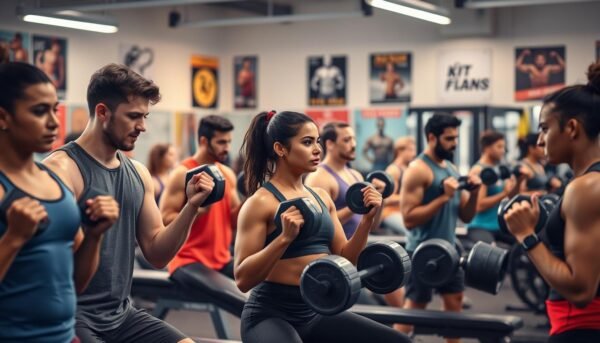
Starting a healthy lifestyle change is a big step. Knowing how weight training and fat loss work is key to reaching your fitness goals. Let’s explore how building muscle through weight training can help your metabolism and aid in weight control.
How Muscle Building Affects Metabolism
Weight training isn’t just for getting big. It’s a vital part of a balanced fitness plan for healthy lifestyle changes. Building lean muscle through strength training boosts your metabolic rate. This makes your body better at burning calories, even when you’re not moving.
A 2021 review in Nutrients found that losing weight can mean losing muscle and bone. But, using fitness motivation from weight training helps keep and build muscle. This is key for a healthy metabolism.
The Role of Hormones in Fat Loss
Strength training is better for fat loss than intense cardio. It doesn’t raise cortisol levels as much. This hormonal balance is vital for keeping and growing muscle. It also helps with a healthy calorie deficit and weight loss.
Caloric Deficit and Exercise Balance
Creating a sustainable caloric deficit is key for weight loss. Exercise is important, but diet is more crucial (80-90%). Combining weight training with a balanced diet helps you lose fat while keeping and growing muscle.
Weight loss works differently for everyone. Factors like gender and body composition affect how fast you lose weight. But, a smart mix of weight training and diet can help you get healthier and fitter.
Essential Equipment and Gym Setup for Beginners
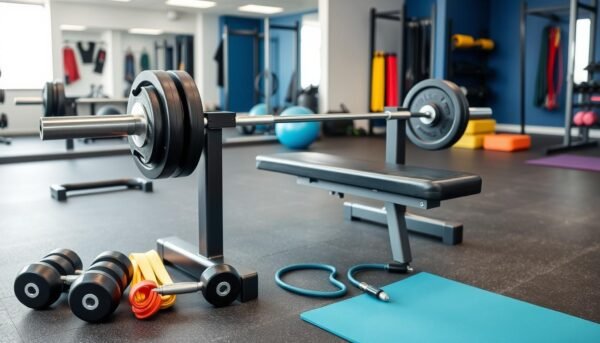
Starting your weight training journey? You’ll need the right gear. Beginners should have dumbbells, resistance machines, and bodyweight exercises. Start with weights that are “medium-light” and let you do 12 reps of basic moves like squats and rows.
Before lifting heavier weights, check your mobility and stability. This ensures you use the right form and avoid injuries. Learning basic moves like squats and push-ups is key. It helps you build a strong base and safely progress in your workouts.
| Equipment | Description | Price Range |
|---|---|---|
| Adjustable Dumbbells | Versatile weights ranging from 10 to 40 pounds per dumbbell | $370 for a 150-pound set |
| Ankle Weights | Offer 1.5- and 3-pound options per pair for added resistance | Around $10 per pair |
| Foam Roller | Effective for self-myofascial release and muscle recovery | Varies, but generally affordable |
| Indoor Cycling Bike | Provides a smooth, quiet ride with 100 resistance levels | Around $1,100 for a beginner model |
Investing in these key pieces will help you build a home gym. It supports your workout and portion control goals. Start with light weights, focus on form, and increase the challenge as you get better.
The Perfect Combination of Diet and Exercise for Weight Loss
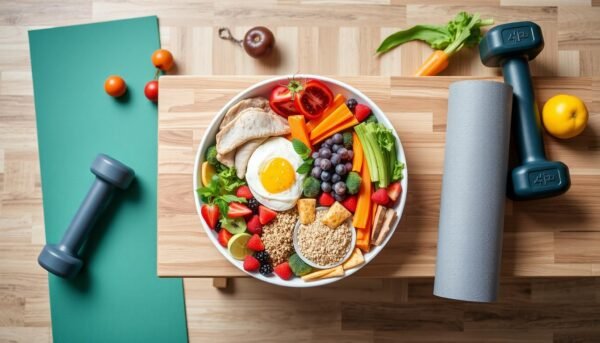
To reach your body transformation goals, you need a smart plan for diet and exercise. Losing weight well means eating less and exercising more. This combo helps you stay healthy and fit.
Protein Requirements for Muscle Growth
Protein is key for growing and keeping muscle. This helps your body burn more calories. Eat 0.73 grams of protein for every pound of your body weight. Good protein sources are lean meats, eggs, dairy, and plant-based foods like beans and tofu.
Timing Your Meals Around Workouts
Eating right before and after workouts boosts your energy and helps you recover. Eat carbs and protein before working out. Then, eat a protein-rich meal or shake within 30 minutes after to help your muscles heal and grow.
Hydration Guidelines
Drinking enough water is vital for losing weight and staying healthy. Drink at least 8 glasses of water a day. If you’re working out hard or it’s hot outside, drink more. Water helps your body work right and recover from exercise.
Remember, what works for someone else might not work for you. Try different diets and exercises to find what works best. With the right mindset and a healthy lifestyle, you can reach your body goals.
Getting Started: Your First Month of Weight Training

Starting a weight loss journey is exciting and can change your life. If you’re new to weight training, the first month is key. It sets the stage for your success. By sticking to a plan, you can lose weight and feel more confident.
Start with one day of strength training and one day of cardio each week. As you get stronger, add more days. Aim for three days of weight training and four days of cardio. This mix helps you lose 50 pounds by building muscle and burning fat.
- Learn the right form and technique first. This prevents injuries and targets the right muscles.
- Do exercises that work many muscles at once. Squats, push-ups, rows, and planks are great. They burn calories and build muscle.
- Make sure to rest and recover well. Your muscles need time to grow and heal.
In the first 4-6 weeks, you’ll start to see changes. Your body will get healthier, and you’ll feel better. Keep going, stay patient, and you’ll see the results.
How to lose 50 pounds Through Strategic Weight Training
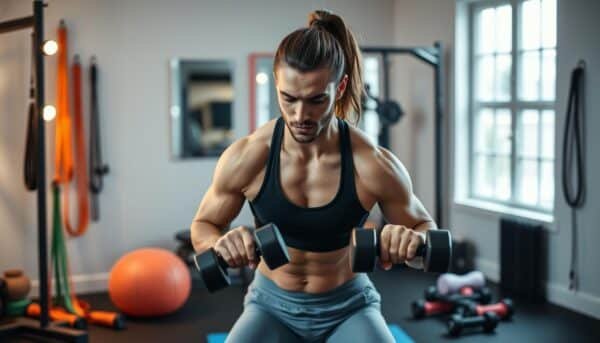
Starting a weight loss journey can seem hard. But with the right plan, you can lose weight and change your body. A good strategy is to mix weight training with a healthy lifestyle.
Progressive Overload Techniques
To lose 50 pounds, use progressive overload in your workouts. This means slowly adding more weight, reps, or sets. It challenges your muscles and helps you burn more calories and fat.
Weekly Workout Structure
Make sure your workouts include full-body exercises. Focus on compound movements that work many muscles at once. Also, add cardio like brisk walking or cycling to burn more fat.
Tracking Progress Methods
It’s important to track your progress. Weigh yourself weekly, take body measurements, and take progress photos. Set goals to lose 1-2 pounds a week. Adjust your diet and workout plan as needed.
By combining weight training with a fat burning diet and a healthy lifestyle change, you can lose 50 pounds. Remember, staying consistent and patient is key to reaching your goals.
Fundamental Weight Training Exercises for Beginners
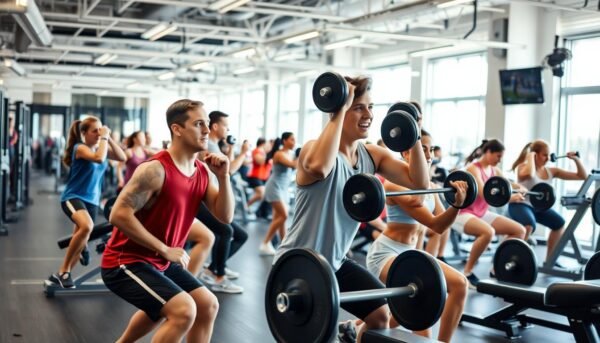
Starting your fitness journey means learning the basics of weight training. These exercises help build strength, muscle, and improve health. Let’s look at some key exercises for beginners to kickstart your fitness journey.
Compound Exercises for Total-Body Strength
Compound exercises work many muscles at once. Start with goblet squats, bent-over rows, and lateral lunges. They work your legs, core, and back, helping you burn calories and build muscle.
Single-Arm Exercises for Balance and Stability
Single-arm exercises like renegade rows and Russian twists boost balance and core strength. They make your body work harder, leading to better fitness.
Progression and Proper Technique
Start with bodyweight versions and add weights as you get stronger. Learning the right technique is key. Do 3-5 sets of 10-12 reps for each exercise, adjusting as needed.
A balanced weight training program is essential. It should include exercises for the upper body, lower body, and core. Stay consistent and patient to see results.
| Exercise | Description | Targeted Muscle Groups |
|---|---|---|
| Goblet Squat | Stand with feet shoulder-width apart, holding a dumbbell or kettlebell close to your chest. Sit back and down, keeping your chest up and core engaged. | Quadriceps, Hamstrings, Glutes, Core |
| Bent-Over Row | Hinge at the hips to bring your torso parallel to the floor, keeping your back flat. Row a dumbbell or barbell up towards your chest, squeezing your shoulder blade. | Back, Biceps |
| Lateral Lunge | Step out to the side with one leg, sitting your hips back and down. Push back to the starting position and repeat on the other side. | Quadriceps, Hamstrings, Glutes |
| Renegade Row | Assume a push-up position with your hands on dumbbells. Keeping your core braced, row one dumbbell up to your chest, then switch sides. | Back, Shoulders, Core |
| Russian Twist | Sit on the floor with your knees bent and feet lifted. Twist your torso from side to side, tapping the floor with a weight or medicine ball. | Obliques, Core |
Creating Your Weekly Workout Schedule
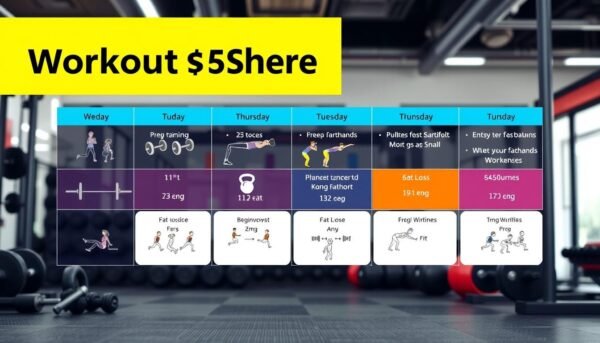
Making a good weekly workout plan is key for your body transformation. Mix strength training and cardio to lose fat and build muscle. Find the right balance for your fitness level and goals.
Rest and Recovery Periods
Resting and recovering is vital for portion control and muscle growth. Have 1-2 rest days a week for stretching or yoga. This lets your muscles fix and grow for the next workout.
Balancing Cardio and Strength Training
Your routine should mix cardio and strength training. Do 2-3 strength workouts and 3-4 cardio sessions weekly. This combo burns calories and builds muscle, helping your body transformation.
Stay consistent. Start with a plan you can handle and get tougher as you get stronger. Listen to your body and adjust your plan to reach your fitness goals.
Common Mistakes to Avoid During Weight Training
Starting my weight training journey, I must watch out for common mistakes. One big one is lifting too much too soon. This can hurt my form, increase injury risk, and slow muscle growth. I’ll start with the basics and slowly add more weight and intensity.
Another mistake is skipping warm-ups and cool-downs. Not doing these can cause stiffness, soreness, and injuries. I’ll make time for dynamic stretches, light cardio, and mobility exercises before and after each workout.
It’s also important not to only do cardio for weight loss. Cardio is good, but strength training is key for building muscle and boosting metabolism. By mixing cardio and weightlifting, I’ll see better results in losing weight and improving my body.
This post may contain affiliate links which means I may receive a commission for purchases made through links. I will only recommend products that I have personally used! Learn more on my Private Policy page.